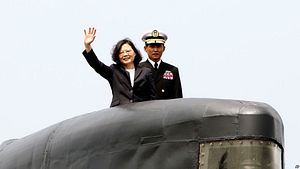Six companies have reportedly submitted design proposals for the Republic of China Navy’s (ROCN) future fleet of domestically-designed and produced diesel-electric attack submarines (SSK). This includes two European and two U.S. firms, as well as an Indian company and a Japanese defense contractor, according to local media reports.
The Indian team that submitted a design proposal is drawn up from naval engineers working on the Indian Navy’s SSK fleet, which includes the Sindhughosh-class (Russian-made Kilo-class), Shishumar-class (German Type 209), and the new Kalvari-class (Scorpene-class) boats, whereas the Japanese team consists of retired engineers from Mitsubishi and Kawasaki Heavy Industries — Japan’s two principal sub makers.
Interestingly, the Japanese team submitted its proposal at the special request of a U.S. defense firm, which has contracted them to solicit their expertise on diesel-electric submarine designs. According to the media report, the Indian team’s proposal includes design elements found on nuclear-powered attack submarines. Taiwan Ministry of Defense officials in conjunction with U.S. defense contractors are reportedly in the process of evaluating the design proposals.
Preliminary design work for Taiwan’s so-called Indigenous Defense Submarine (IDS) program, which was kicked off in December 2014, is expected to be completed by the end of 2018. Construction of the first sub is expected to begin in 2020. As I reported in March 2017, the IDS program is divided up into two phases:
The first phase consists of completing design work on Taiwan’s new class of attack subs for which the government allocated approximately NT$2 billion ($65.66 million). The second stage entails the construction of the new boats with the ambitious goal of finishing construction in eight years and commissioning the subs into service with the ROCN within a decade. (Each sub could cost as much as $1 billion, according to The Diplomat estimates.)
The aim of the IDS program is to build a fleet of eight domestically designed SSKs, each displacing around 1,500 tons, with the first boat entering sea-trials by 2024 followed by its first operational deployment in 2026. This is an ambitious time table and pre-supposes no major technical hick-ups and delays in the construction process, an unlikely proposition given Taiwan’s lack of experience in assembling diesel-electric subs.
Nonetheless as I reported previously, the U.S. Department of State has approved licenses for U.S. defense firms to sell U.S.-made submarine technology to Taiwan in April of this year. Consequently, U.S. defense contractor General Dynamics is expected to offer its AN/BYG-1 submarine combat management system for the indigenous subs.
The combat management system could also be used for the ROCN’s two Hai Lung-class (improved Dutch Zwaardvis-class) submarines, which are expected to be retrofitted between 2020 and 2022, following the completion of a feasibility study of the project conducted by Rotterdam-based RH Marine. (Taiwan also operate two other subs, two World War II-era U.S.-made Guppy-class boats.)
Notably in June 2017, the U.S. State Department also approved the sale of 46 advanced MK-48 Mod 6AT heavyweight torpedoes to the ROCN.































